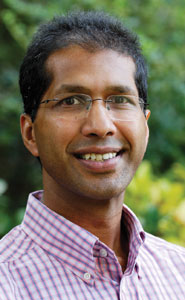Organic synthesis involves the piecing together of smaller organic building blocks until the target molecule is created, but this process is not as simple as putting one row of bricks on top of another. In organic synthesis the two ends of the building blocks first have to be activated in some way to make them attracted to each other so they can bond together. Once bonded, this new molecule is used in another reaction with a different building block, a process which is repeated again and again until the target molecule is formed.
However, as the molecule increases in size and complexity it becomes more and more difficult to activate only the site you want, without other sites being activated as well. As a result, unwanted compounds are formed in addition to the desired molecule. So the molecule has to be extracted from the mixture before the next step of activation and attachment of another building block can occur.
As the starting molecule passes down the assembly line, building blocks are added sequentially with extraordinary precision
The breakthrough Aggarwal and his team of molecular chemists have made is that they have found a way of activating particular building blocks with complete selectivity for a particular site. More importantly, the product formed is ready-primed for reaction with the next building block without the need for further activation. This avoids the arduous task of selectively activating an increasingly complex molecule at a specific site; it is already done through some clever chemical gymnastics.
They have also shown that complex molecules can be created by repeated addition of these building blocks in a process analogous to a molecular assembly line. As the starting molecule passes down the assembly line, building blocks are added sequentially with extraordinary precision so that at the end of the process a complex molecule is created with specific shape and functionality.
It is hoped that the molecular assembly-line process can ultimately be automated so that complex organic molecules with specific architectures and functions can be created simply by pressing a few buttons.
These exciting new developments are enabling a technology with a potentially huge impact. Furthermore, they open up the scientific discipline of organic synthesis from the limited confines of the expert to a much broader pool of scientists. Physicists, molecular biologists and all the disciplines in between will no longer be limited in their scientific quest by molecules they can buy off the shelf – they will be limited only by their imaginations.

